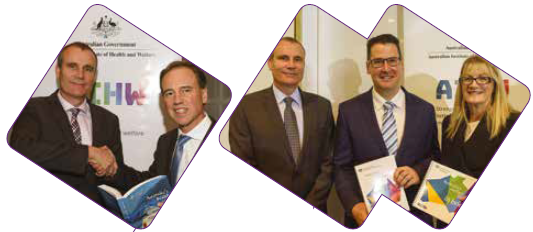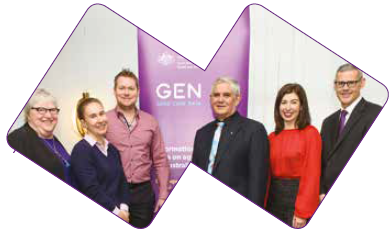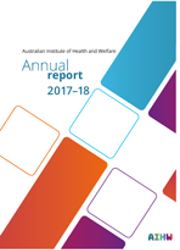Chapter 3 Our communications
This chapter focuses on how we communicate with our audience and stakeholders.
Breaking down the silos and reaching our audiences
In 2017–18, there were many developments in the AIHW’s approach to communicating its work and capabilities. A year after the launch of our Strategic directions 2017–2021, we saw many changes, both in our outputs and the ways in which we communicate them to the outside world.
Over the last year, we launched the new AIHW website, as well as GEN, a new ‘one-stop-shop’ for aged care data. Both websites allow our audiences easier access to our data and products, including increased data visualisation capability and greater use of quick, ‘at a glance’ facts.
While better meeting the needs of our stakeholders through our products is one important component of our communications approach, there has also been significant commitment to strengthening relationships with stakeholders through complementary release activities.
We have done this in part through increased engagement with the health, welfare and data sectors through pre- and post-release activities with a wider network of stakeholders. One particularly notable example of this was during the release of Family, domestic and sexual violence in Australia 2018—the AIHW’s first comprehensive report on this topic.
The report was a significant new piece of work for the AIHW, providing an important resource for those working in family, domestic and sexual violence policy and service delivery. To ensure the report reached those who could use it the most, a detailed stakeholder engagement plan was developed to engage expert groups before the report’s release. These groups included 1800RESPECT and White Ribbon Australia, which were briefed on the key findings of the report and provided with the opportunity to ask questions so they could better understand what the data might mean for their organisation—and for family violence policies and services in the future. This in turn allowed these organisations to promote the report through their own networks and respond to media queries relating to policies, services and survivor perspectives.
The AIHW has increased its engagement with non-government organisations over the past year. This report was a noteworthy example of how effective this practice can be in widening our audiences and ensuring data on significant issues are accessible to those who can use it to effect real change in the health and wellbeing of Australians.
Engaging with stakeholders across and outside government was also a key objective of the AIHW’s first national conference in several years. Held in March 2018, ‘Breaking the Data Silos’ was a joint effort between the Institute and the Australia and New Zealand School of Government. The conference brought together national and international speakers who challenged attendees to think about concepts such as trust and transparency in data, the role of the citizen in managing their own data, and the concept of data as a renewable resource.
The conference was a clear example of 3 of the Institute’s strategic goals in action: ‘Leaders in health and welfare data’; ‘Champions for open and accessible data and information’; and, importantly, ‘Trusted strategic partners’.
As we look forward, we will continue to foster this trust and build these partnerships across an ever-growing audience of data users.
Reaching our audiences
The AIHW is committed to making its work widely accessible and easy to understand. Our information is downloadable free of charge on the AIHW website in a variety of formats to suit individual user's needs. All publications are available in alternative formats upon request.
Notification services for clients and stakeholders
One of our communication channels is a on-the-day email notification service alerting subscribers to new AIHW product releases. As at 30 June 2018, more than 26,000 people subscribed to this service. Subscriptions to these notifications rose by 7.5% in 2017–18 compared with the previous year (Table 3.1).
Table 3.1: Email notification service subscriptions for releases of AIHW products by category, 2013–14 to 2017–2018
| Year at 30 June | 2013–14 | 2014–15 | 2015–16 | 2016–17 | Change 2016–17 to 2017–18 |
2017–18 |
|---|---|---|---|---|---|---|
| For releases of our: | – | – | – | – | – | – |
| health-related products | 5,729 | 5,984 | 6,308 | 6,650 | Increase | 7,234 |
| welfare-related products | 4,426 | 4,670 | 4,947 | 5,250 | Increase | 5,649 |
| education resources and promotions | 3,581 | 4,144 | 4,573 | 5,010 | Increase | 5,617 |
| AIHW Access online newsletter | 4,632 | 5,609 | 6,499 | 7,299 | Increase | 7,519 |
| Total | 18,368 | 20,407 | 22,327 | 24,209 | Increase | 26,019 |
In 2017–18, we continued to use Twitter (@aihw) as a means of communicating with our stakeholders. The AIHW had around 15,800 @aihw followers as at 30 June 2018; an increase of 32% compared with the previous year (12,000 in 2016–17). The number of views of our tweets also rose, with 852,000 ‘impressions’ compared with 786,000 in 2016–17.
We will continue in 2018–19 to increase communication with our Twitter followers through targeted Twitter campaigns.
Spotlight on our products
In 2017–18, we published 144 print-ready publications and 74 web products, including new and updated web snapshots, dynamic data displays and reports in HTML format (see Appendix 2).
The publications most frequently downloaded from the AIHW website in 2017–18 are detailed in Table 3.2. By this measure, Australia’s health 2016 was our most popular report during the year. Australia’s health, our flagship report, has been consistently our most downloaded publication for nearly 20 years.
Table 3.2: Top 10 publications downloaded from the AIHW website, 2017–18
| Rank | Title | Release date |
|---|---|---|
| 1 | Australia's health 2016 | 13 September 2016 |
| 2 | Cancer in Australia 2017 | 3 February 2017 |
| 3 | National Drug Strategy Household Survey 2016: detailed findings | 28 September 2017 |
| 4 | Family, domestic and sexual violence in Australia 2018 | 28 February 2018 |
| 5 | A picture of overweight and obesity in Australia 2017 | 24 November 2017 |
| 6 | Australian Burden of Disease Study: impact and causes of illness and death in Australia 2011 | 10 May 2016 |
| 7 | Australia's health 2018 | 20 June 2018 |
| 8 | Australia's welfare 2017 | 19 October 2017 |
| 9 | The health and welfare of Australia’s Aboriginal and Torres Strait Islander peoples 2015 | 9 June 2015 |
| 10 | A picture of Australia's children 2012 | 31 October 2012 |
Note: These rankings are based on downloads of each report during 2017–18 either for the full year or from the stated release date in 2017–18 to 30 June 2018.
Flagship report overview
The 2017–18 financial year saw the release of the AIHW’s biennial flagship reports. Australia’s welfare 2017 and Australia’s health 2018 were released in October 2017 and June 2018, respectively.
Australia’s welfare 2017 was launched by Senator the Hon Zed Seselja, the then Assistant Minister for Social Services and Multicultural Affairs, on 19 October 2017.
Australia’s health 2018 was launched on 20 June 2018 by the Hon Greg Hunt MP, Minister for Health. In his address to guests, Minister Hunt noted that there was, in his view, ‘no more credentialed and no more respected health data institution in the world’ than the AIHW.

(Left) Barry Sandison (left) and Minister Hunt (right) at the launch of Australia’s health 2018. (Right) left to right: AIHW Director, Barry Sandison, Senator Seselja and Board Chair Louise Markus at the launch of Australia’s welfare 2017.
AIHW website

The AIHW website is the main conduit for all AIHW information; principally our PDF and HTML (web) reports and a range of other data-related outputs including interactive and manipulable outputs. All online products are free to view or download. In September 2017, we launched our new-look website.
The AIHW uses ‘sessions’ as a measure of our web traffic—obtained through Google Analytics. A session is a discrete period of time in which a single visitor is actively engaged with the website.
There were 2.9 million sessions on our website in 2017–18—a slight decrease from 3.0 million in 2016–17.
The AIHW manages 4 additional websites; namely, GEN—Aged Care Data, MyHealthyCommunities, MyHospitals and the Australian Mesothelioma Registry, which address the needs of more specific audiences.

GEN—Aged Care Data was launched on 15 August 2017 by the Minister for Aged Care, the Hon Ken Wyatt AM, MP. GEN gives access to data and information from the NACDC which is managed by the AIHW and is Australia’s only central, independent repository of national aged care data.
GEN is designed to cater for all levels of users, from students seeking information for assignments, right through to data modellers and actuaries. The data and information are presented at different levels. Each section begins with an overview and ‘fast facts’ of the topic, followed by greater detail and the option of interacting with the data.
The data that underpin each topic are available for further analysis and additional data, not necessarily displayed in a topic, are available in the ‘Analyse’ section. If data needed are not available on GEN, they can be requested.
The AIHW and the Department of Health have worked together to develop GEN as part of continuous quality improvement for the NACDC.
GEN has had 52,300 sessions since its launch.

Left to right: AIHW’s Felicty Van Der Zwan, Veronique Thouroude, Nathan Wakefield, Minister Wyatt, AIHW’s Deanne Johnson and Mark Cooper-Stanbury at the GEN launch.

MyHealthyCommunities is an interactive website that enables users to see how their local health area is performing and how it compares with other similar areas. It covers a range of topic areas, including hospitalisations, immunisation rates, patient experiences, participation in screening programs, incidence of cancers and risk factor rates.
There were just over 57,000 sessions on this website in 2017–18—a 16% increase over 2016–17 (49,000).

The MyHospitals website provides nationally consistent, locally relevant information that allows fair comparisons to be made between individual hospitals or health services. The intended audience for this website includes: members of the public; clinicians, including doctors and nurses; academics and researchers; hospital and health service managers; and journalists.
There were nearly 868,000 sessions on this website in 2017–18—a 13% increase over 2016–17 (770,000).

The Australian Mesothelioma Registry (AMR) has been managed by the AIHW on behalf of Safe Work Australia since July 2017. The AMR contains information about people with mesothelioma, monitors all new cases diagnosed from 1 July 2010 in Australia and collects information about asbestos exposure. The AMR helps the Australian Government develop policies to best deal with the asbestos still present in Australia’s buildings and environment, with the aim of reducing mesothelioma in the future.
Session numbers will be available from 2018–19.
Media coverage
The AIHW issued 37 media releases in 2017–18, 2 more than in 2016–17. Media coverage remained steady over this period due to the issue of several high-profile media releases during the year (for example, domestic violence, immunisation and increased local-level reporting).
Compared with 2016–17, the AIHW’s media coverage increased most notably in 2017–18 for television (up 23.5%) and print (up 13.5%). Radio coverage saw a slight increase (up 0.5%) while online coverage dropped 9%. Table 3.3 provides the number of media mentions from 2013–14 to 2017–18.
Table 3.3: Media coverage (items) and media releases, 2013–14 to 2017–18
| Media type | 2013–14 | 2014–15 | 2015–16 | 2016–17 | Change 2016–17 to 2017–18 |
2017–18 |
|---|---|---|---|---|---|---|
| 507 | 426 | 798 | 1,694 | Increase | 1,923 | |
| Radio | 1,620 | 1,826 | 1,106 | 1,617 | Increase | 1,629 |
| Television | 122 | 230 | 129 | 221 | Increase | 273 |
| Online | 1,311 | 1,650 | 1,496 | 1,822 | Decrease | 1,645 |
| Australian Associated Press | 15 | 41 | 37 | . . | . . | . . |
| Total | 3,575 | 4,173 | 3,566 | 5,354 | Increase | 5,472 |
| Media releases | 80 | 82 | 57 | 35 | Increase | 37 |
. . not applicable
Media coverage of individual reports
The AIHW’s National Drug Strategy Household Survey 2016: detailed findings, Family, domestic and sexual violence in Australia 2018 and Australia’s health 2018 reports attracted the most media coverage in 2017–18. The top 10 reports for media coverage are listed in Table 3.4.
Table 3.4: Top 10 reports for media coverage, 2017–18
| Rank | Title | Media mentions |
|---|---|---|
| 1 | National Drug Strategy Household Survey 2016: detailed findings | 234 |
| 2 | Family, domestic and sexual violence in Australia 2018 | 202 |
| 3 | Australia's health 2018 | 200 |
| 4 | Non-medical use of pharmaceuticals: trends, harms and treatment, 2006–07 to 2015–16 | 183 |
| 5 | MyHealthyCommunities: Immunisation rates for children 2016–17 MyHealthyCommunities: HPV immunisation rates 2015–16 |
142 |
| 6 | Participation in national cancer screening programs in 2015–2016 Incidence of selected cancers in 2009–2013 MyHealthyCommunities: Child and maternal health in 2013–2015 |
90 |
| 7 | Cancer in Aboriginal and Torres Strait Islander people of Australia | 89 |
| 8 | Elective surgery waiting times 2016–17: Australian hospital statistics | 88 |
| 9 | Child protection Australia 2016–17 | 79 |
| 9 | MyHealthyCommunities: Life expectancy and potentially avoidable deaths in 2013–2015 MyHealthyCommunities: Health risk factors in 2014–15: lifetime risky alcohol consumption MyHealthyCommunities: Health risk factors in 2014–15: high blood pressure MyHealthyCommunities: Health risk factors in 2014–15: insufficient physical activity |
78 |
| 10 | A picture of overweight and obesity in Australia 2017 Overweight and obesity in Australia: a birth cohort analysis |
73 |
Parliamentary relations
Budget estimates hearings
The AIHW Director was not called to appear before the Senate Community Affairs Legislation Committee in 2017–18. The AIHW provided responses to 4 questions on notice and input for 4 portfolio-wide responses to questions on notice arising from Senate Estimates hearings occurring during 2017–18.
Inquiries
The AIHW provided 5 submissions to parliamentary and government committee inquiries in 2017–18 (Table 3.5). Staff appeared before 2 committees during the year, the Inquiry into Local Adoption of Children in Australia and the Victorian Drug Law Reform Inquiry.
Table 3.5: Submissions to parliamentary and government inquiries, 2017–18
| Committee | Inquiry name |
|---|---|
| Australian Government | — |
| Senate Standing Committee on Community Affairs | Inquiry into the Value and Affordability of Private Health Insurance and Out-of-pocket Medical Costs |
| House of Representatives Standing Committee on Health, Aged Care and Sport | Quality of Care in Residential Aged Care Facilities in Australia |
| House of Representatives Standing Committee on Social Policy and Legal Affairs | Inquiry into Local Adoption of Children in Australia |
| Senate Select Committee on Stillbirth Research and Education | Stillbirth Research and Education Inquiry |
| State/territory | — |
| Parliament of NSW-Legislative Council | Inquiry into the Alcoholic Beverages Advertising Prohibition Bill |



